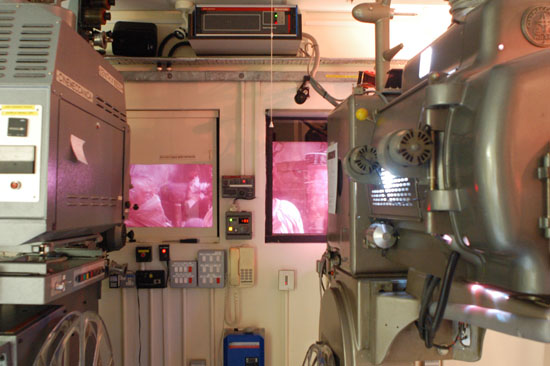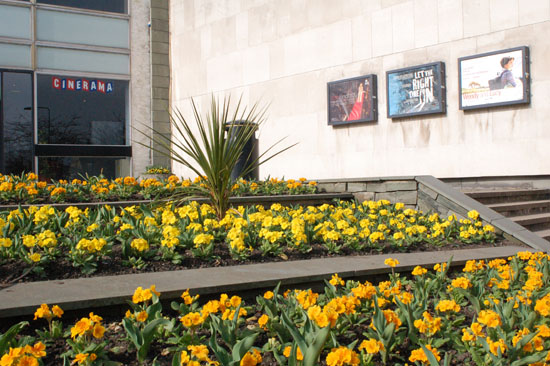Introduction to "The King and I" |
Read more
at in70mm.com The 70mm Newsletter |
| Written by: Wolfram Hannemann | Date: 11.04.2009 |
 Good Evening, Ladies & Gentlemen and Good Evening, Ladies & Gentlemen and Hello Widescreen Enthusiasts! May I introduce myself? My name is Wolfram Hannemann and I am a movie buff from good old Germany and it is my sixth visit already to the Widescreen Weekend in Bradford. Besides my work as a free lance journalist I am also running my own mail order company trying to sell – well, don’t get angry with me – DVDs and Blu-rays. During last year’s 70mm film festival in Karlsruhe, Germany, where I usually do introductions for most of the films I was asked by one of our guests whether I would be willing to do some intros in Bradford as well. „Sure“, I said – „why not“. The guest in question was our Chief of Projection here at Pictureville, Duncan McGregor. Well, knowing Duncan’s fantastic sense of humor I suspect that the only reason he asked me to do this is that he wanted you to listen to my funny German accent. So please be patient with me and my bad English. Trust me – it is far better than my German! "The King and I" from 1956 was the second and last feature film to be made in CinemaScope 55. The 55mm negative combined with an anamorphic lens had four times the size of a conventional 35mm CinemaScope frame. The system was developed by Twentieth Century Fox and introduced in 1956 with their production of Rodgers & Hammerstein’s "Carousel", which will be screened this Sunday. Although it was intended to release 55mm prints of "Carousel" the studio executives decided that 35mm reduction prints would do after having seen the amazing quality of such reduction prints compared to conventional CinemaScope prints. On the other hand, "The King and I" made it with a very limited number of 55mm prints into some theatres at least. However, after that Fox dropped the system in favour of Todd-AO. "The King and I" was directed by Walter Lang from a screenplay by Ernest Lehman which was adapted from Rodgers and Hammerstein’s stage musical. Alfred Newman served as music supervisor and conductor and Leon Shamroy was Director of Photography. After "The King and I" Shamroy would go on the shoot some of the big Todd-AO films, including "South Pacific", "Porgy and Bess" and "Cleopatra". As far as trivia goes, we do have three connections between this version of "The King and I" and "West Side Story" (which will be screened on Saturday). First: actress Rita Moreno appears in both films. Dorothy Dandridge, the first African American woman to be nominated for an Academy Award for Best Actress in Carmen Jones (1954), was the original choice for the role of Tuptim, played by Moreno. It is reported that Miss Dandridge was strongly advised to refuse the role because Tuptim was a slave. The role went to Rita Moreno. |
More
in 70mm reading: “Broadsword Calling Danny Boy” Widescreen Weekend Report 2009 WSW 2009 program Widescreen Weekend Home Mr. Derren Nesbitt ("Major von Hapen" in "Where Eagles Dare") Lost Orphaned Films Abandoned in Basement The History of 70mm Short Subjects Ramon's WSW review and Audience feedback Images: Friday, Saturday and Sunday "Audience on Stage" and Academy of the Wide Screen Weekend Film Introductions: "The Bible...in the beginning" "How the West Was Won" "Khartoum" "This is New Zealand" "West Side Story" "Faubourg 36" 70mm in Paris "This is New Zealand" 3-strip EXPO Film From New Zealand The M.C.S.-70 Process Internet link: |
 Second: Marni Nixon, who dubbed Deborah Kerr's singing in the film, also dubbed Natalie Wood’s singing voice in "West Side Story". Marni Nixon was hired on a six-week contract for
"The King and I", and she was to be at the studio every day that Deborah Kerr in the role of Anna rehearsed a scene with a song in it. Nixon would actually stand next to Kerr and walk through the whole scene - both of them singing - and Nixon would be looking closely at Kerr's facial expressions to try to imitate her speech pattern in the songs. Marni Nixon said that she realized the keys of Anna's songs were very low for her - "very contralto keys" - and that she was really too young (just 21) to be able to sound "adult" and "womanly". Hence, a modifier was placed in Nixon's microphone, to make her voice sound deeper and more mature. "I have a very light, bright ring to my voice, and I tried to take that out" she said. "But they were able to use this modifier to emphasize the lower partials of my voice. I also remember having a terrible cold at the time, not being able to breathe in those recording sessions. But that probably helped in matching Deborah's voice, deepening it." Second: Marni Nixon, who dubbed Deborah Kerr's singing in the film, also dubbed Natalie Wood’s singing voice in "West Side Story". Marni Nixon was hired on a six-week contract for
"The King and I", and she was to be at the studio every day that Deborah Kerr in the role of Anna rehearsed a scene with a song in it. Nixon would actually stand next to Kerr and walk through the whole scene - both of them singing - and Nixon would be looking closely at Kerr's facial expressions to try to imitate her speech pattern in the songs. Marni Nixon said that she realized the keys of Anna's songs were very low for her - "very contralto keys" - and that she was really too young (just 21) to be able to sound "adult" and "womanly". Hence, a modifier was placed in Nixon's microphone, to make her voice sound deeper and more mature. "I have a very light, bright ring to my voice, and I tried to take that out" she said. "But they were able to use this modifier to emphasize the lower partials of my voice. I also remember having a terrible cold at the time, not being able to breathe in those recording sessions. But that probably helped in matching Deborah's voice, deepening it."And third: both "The King and I" and "West Side Story" share the same choreographer – Jerome Robbins. Regarding "The King and I"’s cast, Brynner and Kerr were not the original choices for the film version. Marlon Brando at one point was considered to play the King. And Darryl F. Zanuck first cast Maureen O’Hara as Anna. She was not only gorgeous but had a fine soprano voice and would not have to be dubbed. Richard Rodgers agreed that O'Hara had a great voice but reportedly said, "No pirate queen is going to play my Anna!". It was Yul Brynner, by the way, who pushed for Deborah Kerr to be cast as Anna. He had seen some of her stage work, was highly impressed with her and was convinced that she was the one for the role In 2003 Twentieh Century Fox undertook the enormous task to restore their two feature films photographed in CinemaScope 55. With Schawn Belston and Simon Lund as project supervisors Fox had the best men to do the job. The print we will be screening tonight is an anamorphic 35mm print which was restored from the original 55mm negative. In favor of putting the whole frame with its aspect ratio of 1:2.55 into a standard CinemaScope 1:2.35 frame without cropping it, the picture was slightly reduced in size, introducing black bars separating the individual frames. This means that the projected picture you are going to see has the full width of our standard CinemaScope screen, but slightly less height than standard CinemaScope. By doing this you will be seeing the picture as it was intended by the filmmakers. Not even the 70mm version made in 1961 under the label „Grandeur 70“ did preserve the original aspect ratio, but was slightly cropped at one side. The intermission which was introduced for the 70mm road show engagements has been eliminated in this restored version bringing us closer to the fimmakers‘ intentions. The original multi channel magnetic stereo sound was remastered into a 5.1 Dolby Digital soundtrack. And now, ladies and gentlemen, to put it in the King of Siam’s words, enjoy "The King and I" as originally intended et cetera, et cetera, et cetera! |
|
|
Go: back
- top - back issues
- news index Updated 22-01-25 |
|
